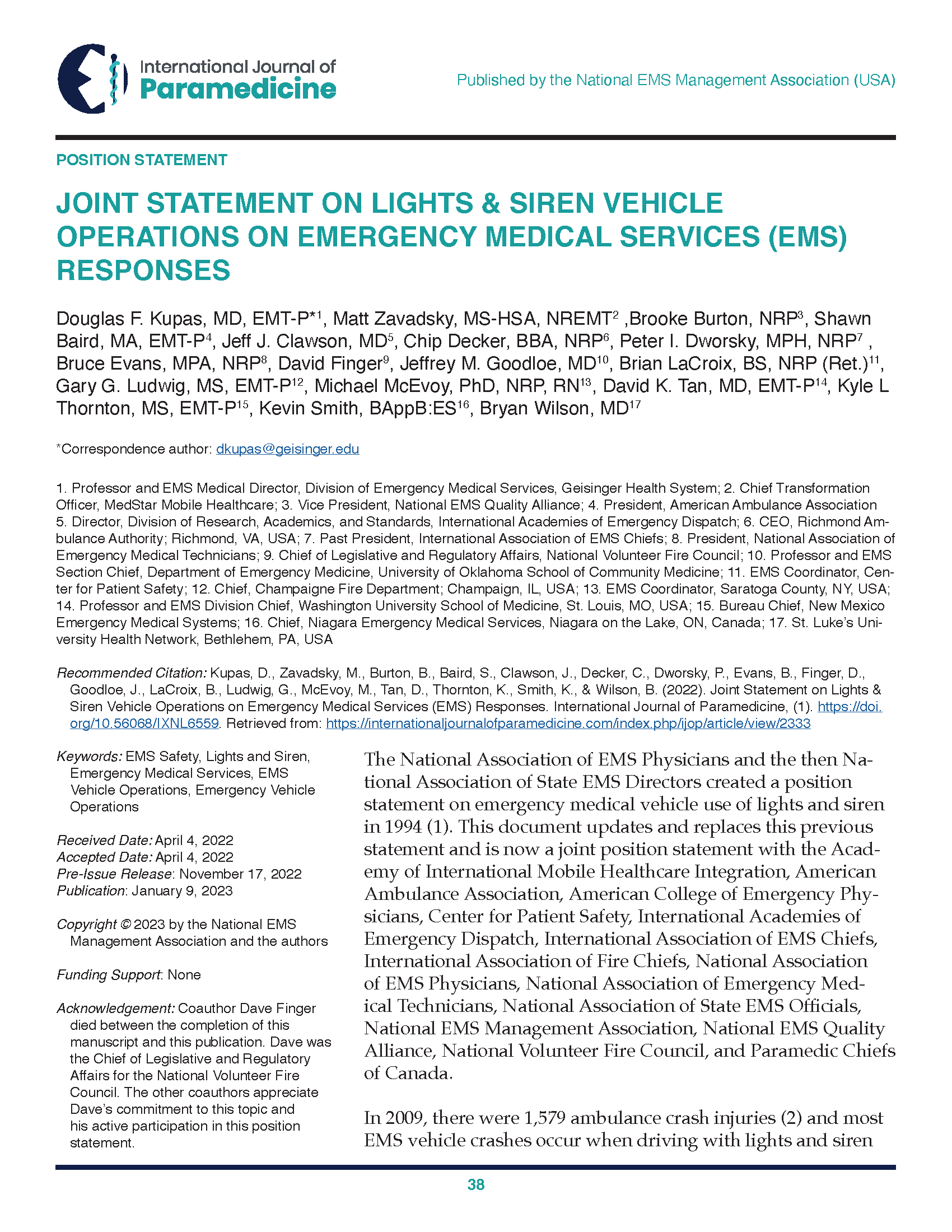Joint Statement on Lights & Siren Vehicle Operations on Emergency Medical Services (EMS) Responses
Main Article Content
Abstract
none
Article Details

This work is licensed under a Creative Commons Attribution-ShareAlike 4.0 International License.
Publishing in IJOP allows authors to keep their copyright while giving IJOP unrestricted copyright permissions. Articles published in IJOP use Creative Common Attribution 4.0 International (CC BY-ND 4.0) licensing. This license requires that re-users give credit to the creator. It allows re-users to copy and distribute the material in any medium or format in unadapted form only, even for commercial purposes. Additional terms apply and can be accessed here.
Publishing in IJOP also allows authors to have contracts for non-exclusive distribution of the Journal's published version of the article, such as posting to an institutional repository or publication in a book, on the condition that the original publication in the original layout format in IJOP is retained and acknowledged.
We permit and encourage authors to post the articles they published in IJOP on their affiliated websites. This helps share the information, encourages citation in other works, and promotes scholarly discourse in the spirit of open access.
References
National Association of EMS Physicians: Use of warning lights and siren in emergency medical vehicle response and patient transport. Prehosp and Disaster Med. 1994;9(2):133-136. https://doi.org/10.1017/s1049023x00041030
Grant CC, Merrifield B: Analysis of ambulance crash data. The Fire Protection Research Foundation. 2011. Quincy, MA.
Kahn CA, Pirallo RG, Kuhn EM: Characteristics of fatal ambulance crashes in the United States: an 11-year retrospective analysis. Prehosp Emerg Care. 2001;5(3):261-269. https://doi.org/10.1080/10903120190939751
Ray AF, Kupas DF: Comparison of crashes involving ambulances with those of similar-sized vehicles. Prehosp Emerg Care. 2005;9(4):412-415. https://doi.org/10.1080/10903120500253813
U.S. Fire Administration. Firefighter fatalities in the United States in 2013. 2014. Emmitsburg, MD. https://www.usfa.fema.gov/downloads/pdf/publications/ff_fat14.pdf (Accessed: 09Sep2022)
Maguire BJ: Transportation-related injuries and fatalities among emergency medical technicians and paramedics. Prehosp Disaster Med. 2011;26(5):346-352. https://doi.org/10.1017/s1049023x11006601
Maguire BJ, Hunting KL, Smith GS, Levick NR: Occupational fatalities in emergency medical services: A hidden crisis. Ann Emerg Med, 2002;40:625-632. https://doi.org/10.1067/mem.2002.128681
Drucker C, Gerberich SG, Manser MP, Alexander BH, Church TR, Ryan AD, Becic E: Factors associated with civilian drivers involved in crashes with emergency vehicles. Accident Analysis & Prevention. 2013;55:116-23. https://doi.org/10.1016/j.aap.2013.02.035
Clawson JJ, Martin RL, Cady GA, Maio RF: The wake effect: emergency vehicle-related collisions. Prehosp Disaster Med. 1997;12(4):274-277.
Kupas DF: Lights and siren use by emergency medical services: Above all, do no harm. National Highway Traffic Safety Administration. 2017. https://www.ems.gov/pdf/Lights_and_Sirens_Use_by_EMS_May_2017.pdf
Watanabe BL, Patterson GS, Kempema JM, Magailanes O, Brown LH: Is use of warning lights and sirens associated with increased risk of ambulance crashes? A contemporary analysis using national EMS information system (NEMSIS) data. Ann Emerg Med. 2019;74(1):101-109. https://doi.org/10.1016/j.annemergmed.2018.09.032
Jarvis JL, Hamilton V, Taigman M, Brown LH: Using red lights and sirens for emergency ambulance response: How often are potentially life-saving interventions performed? Prehosp Emerg Care. 2021;25(4):549-555. https://doi.org/10.1080/10903127.2020.1797963

